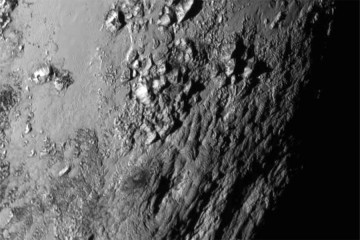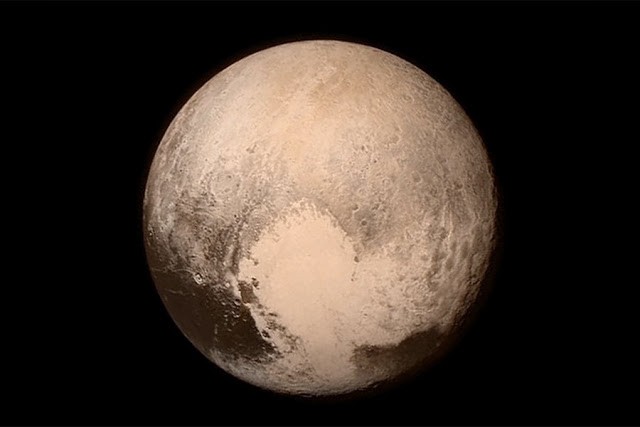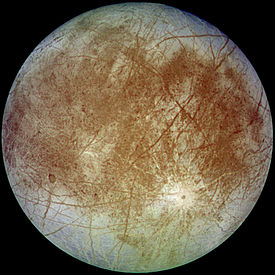

| Online: | |
| Visits: | |
| Stories: |

| Story Views | |
| Now: | |
| Last Hour: | |
| Last 24 Hours: | |
| Total: | |
A Solar System With 110 Planets, and It’s Ours
Johns Hopkins University scientist Kirby Runyon wants to make one thing clear: Regardless of what one prestigious scientific organization says to the contrary, Pluto is a planet. So is Europa, commonly known as a moon of Jupiter, and the Earth’s moon, and more than 100 other celestial bodies in our solar system that are denied this status under a prevailing definition of “planet.”
The definition approved by the International Astronomical Union in 2006 demoted Pluto to “non-planet,” thus dropping the number of planets in our solar system from nine to eight. The change—a subject of much scientific debate—made no sense, says Runyon, lead author of a short paper making the pro-Pluto argument that will be presented next week at a scientific conference in Texas.
Pluto nearly fills the frame in this image from the Long Range Reconnaissance Imager (LORRI) aboard NASA’s New Horizons spacecraft, taken on July 13, 2015, when the spacecraft was 476,000 miles from the surface. This is the last and most detailed image sent to Earth before the spacecraft’s closest approach to Pluto on July 14. The color image has been combined with lower-resolution color information from the Ralph instrument that was acquired earlier on July 13.
Remarkable new details of Pluto’s largest moon, Charon, are revealed in this image taken by New Horizons late on July 13, 2015, from a distance of 289,000 miles. A swath of cliffs and troughs stretches about 600 miles left to right, suggesting widespread fracturing of Charon’s crust, likely a result of internal processes. At upper right, along the moon’s curving edge, is a canyon estimated to be 4 to 6 miles deep.
Runyon, whose doctoral dissertation focuses on changing landscapes on the moon and Mars, led a group of six authors from five institutions in drafting the definition and its justification that will be presented at the Lunar and Planetary Science Conference‘s poster session. The poster will be on view for a full day on March 21 at the conference sponsored by the Lunar and Planetary Institute, and Runyon will be on hand for at least three hours to answer questions about it.
All the authors are science team members on the New Horizons mission to Pluto, operated for NASA by the Johns Hopkins University Applied Physics Laboratory. In the summer of 2015, the New Horizons spacecraft became the first to fly by Pluto, passing within 8,000 miles and sending back the first closeup images ever made of Pluto. The flyby occurred when Pluto was 3 billion miles from Earth, although its orbit takes it as far as 4.67 billion miles away.
New close-up images taken by NASA’s New Horizons spacecraft of a region near Pluto’s equator reveal a range of youthful mountains rising as high as 11,000 feet (3,500 meters) above the planet’s surface.

Credit: NASA / JHUAPL / Southwest Research Institute
This definition differs from the three-element IAU definition in that it makes no reference to the celestial body’s surroundings. That portion—which required that a planet and its satellites move alone through their orbit—excluded Pluto. Otherwise, Pluto fit the IAU definition: it orbits the sun and it is massive enough that the forces of gravity have made it round.
Stern has argued in the past that the IAU definition also excludes Earth, Mars, Jupiter, and Neptune, which share their orbits with asteroids.
This processed image is the highest-resolution color look yet at the haze layers in Pluto’s atmosphere. Shown in approximate true color, the picture is constructed from a mosaic of four panchromatic images from the Long Range Reconnaissance Imager splashed with Ralph/Multispectral Visible Imaging Camera four-color filter data, all acquired by NASA’s New Horizons spacecraft on July 14, 2015. The resolution is 0.6 miles per pixel; the sun illuminates the scene from the right.

Credit: NASA
The new geophysical definition omits stars, black holes, asteroids, and meteorites, but it includes everything else in our solar system. It would expand the number of planets from eight to approximately 110.
That expansion is part of the appeal of the new definition, says Runyon. He says he would like to see the public more engaged in solar system exploration. As the very word “planet” seems to carry a “psychological weight,” he figures that more planets could encourage that public interest.
The new definition, which does not require approval from a central governing body, is also more useful to planetary scientists. Most of them are closely affiliated with geology and other geosciences, thus making the new geophysical definition more useful than the IAU’s astronomical definition.
“I want the public to fall in love with planetary exploration as I have,” said Runyon. “It drives home the point of continued exploration.”
Source:





